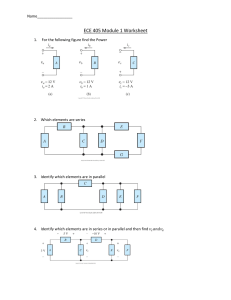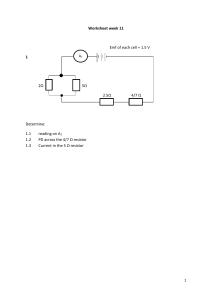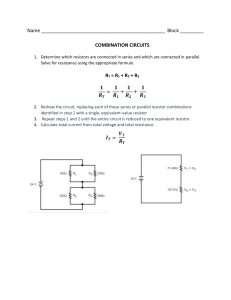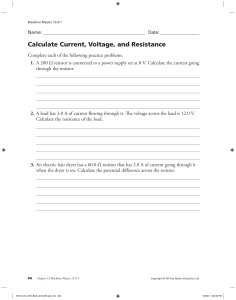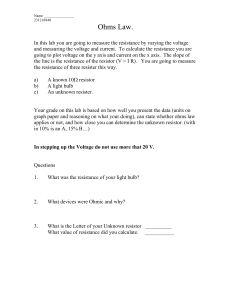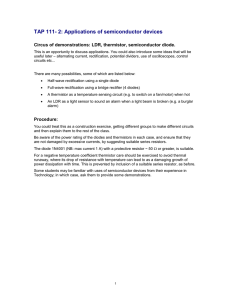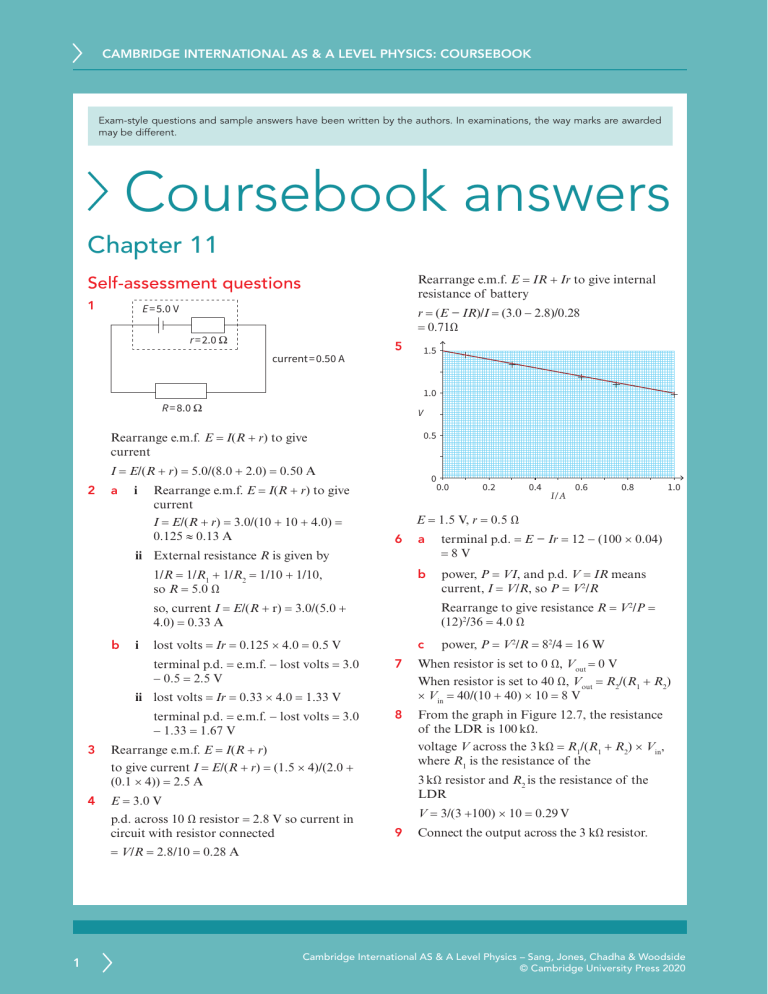
CAMBRIDGE INTERNATIONAL AS & A LEVEL PHYSICS: COURSEBOOK Exam-style questions and sample answers have been written by the authors. In examinations, the way marks are awarded may be different. Coursebook answers Chapter 11 Rearrange e.m.f. E = IR + Ir to give internal resistance of battery Self-assessment questions 1 E = 5.0 V r = (E − IR)/I = (3.0 − 2.8)/0.28 = 0.71Ω r = 2.0 Ω current = 0.50 A 5 1.5 1.0 R = 8.0 Ω V 0.5 Rearrange e.m.f. E = I(R + r) to give current I = E/(R + r) = 5.0/(8.0 + 2.0) = 0.50 A 2 a i Rearrange e.m.f. E = I(R + r) to give current I = E/(R + r) = 3.0/(10 + 10 + 4.0) = 0.125 ≈ 0.13 A 0 0.0 6 1/R = 1/R1 + 1/R2 = 1/10 + 1/10, so R = 5.0 Ω b 3 4 c 0.8 1.0 power, P = VI, and p.d. V = IR means current, I = V/R, so P = V2/R power, P = V2/R = 82/4 = 16 W 7 hen resistor is set to 0 Ω, Vout = 0 V W When resistor is set to 40 Ω, Vout = R2/(R1 + R2) × Vin = 40/(10 + 40) × 10 = 8 V 8 rom the graph in Figure 12.7, the resistance F of the LDR is 100 kΩ. voltage V across the 3 kΩ = R1/(R1 + R2) × Vin, where R1 is the resistance of the Rearrange e.m.f. E = I(R + r) to give current I = E/(R + r) = (1.5 × 4)/(2.0 + (0.1 × 4)) = 2.5 A E = 3.0 V p.d. across 10 Ω resistor = 2.8 V so current in circuit with resistor connected 0.6 Rearrange to give resistance R = V2/P = (12)2/36 = 4.0 Ω iilost volts = Ir = 0.33 × 4.0 = 1.33 V terminal p.d. = e.m.f. − lost volts = 3.0 − 1.33 = 1.67 V I/A a terminal p.d. = E − Ir = 12 − (100 × 0.04) =8V b ilost volts = Ir = 0.125 × 4.0 = 0.5 V terminal p.d. = e.m.f. − lost volts = 3.0 − 0.5 = 2.5 V 0.4 E = 1.5 V, r = 0.5 Ω iiExternal resistance R is given by so, current I = E/(R + r) = 3.0/(5.0 + 4.0) = 0.33 A 0.2 3 kΩ resistor and R2 is the resistance of the LDR V = 3/(3 +100) × 10 = 0.29 V 9 Connect the output across the 3 kΩ resistor. = V/R = 2.8/10 = 0.28 A 1 Cambridge International AS & A Level Physics – Sang, Jones, Chadha & Woodside © Cambridge University Press 2020 CAMBRIDGE INTERNATIONAL AS & A LEVEL PHYSICS: COURSEBOOK 10 T he thermistor is connected in series with a fixed resistor and a battery. A changing temperature will cause a changing voltage across the thermistor. 11 Both are made from a semiconductor material. Both have a decreasing resistance: for an LDR when the light intensity increases and for a thermistor when the temperature increases. Both have a non-linear change in resistance with light intensity or temperature. 12 The resistance of the thermistor at 50° C is 400 Ω so the resistor must have the same value. 13 a For a 1 cm length of wire, potential difference = 4.0/100 = 0.04 V length needed for 1.0 V = 1.0/0.04 = 25 cm b Vout c he output voltage is shown across the 400 T Ω resistor. When the temperature rises, the 2 length of 37.0 cm has a p.d. across it of A 37.0 × 0.04 = 1.48 V The driver cell will have internal resistance and it is supplying current to the potentiometer wire. Therefore, the p.d. across its terminals and the wire will be slightly less than the e.m.f. (4.0 V) of the cell. 10 V 400 Ω resistance of the thermistor decreases and so the p.d. across the thermistor decreases and the p.d. across the 400 Ω resistor increases. You can instead put the output voltage across the thermistor, then, when temperature rises, the output voltage falls. I f a balance length of 31.2 cm is required by a cell of e.m.f. 1.230 V, then p.d. supplied by unknown e.m.f. cell = (1.230 × 37.0)/31.2 = 1.459 V ≈ 1.46 V Cambridge International AS & A Level Physics – Sang, Jones, Chadha & Woodside © Cambridge University Press 2020
